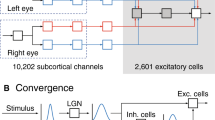Summary
When an animal is reared with goggles containing stripes of a single orientation, many cells in the visual cortex become abnormal. To find out whether these abnormal cells result from orientation deprivation per se or from other features of goggle rearing we reared kittens with goggles containing stripes of many orientations. The data suggest that orientation deprivation contributes to the development of abnormal cells but is not its sole cause.
Similar content being viewed by others
References
Blakemore C, Cooper GF (1970) Development of the brain depends on the visual environment. Nature 228: 477–478.
Blakemore C, Donaghy MJ, Maffei L, Movshon JA, Rose D, Van Sluyters RC (1974) Evidence that nitrous oxide can maintain anesthesia after induction with barbiturates. J Physiol (Lond) 237: 39P-40P.
Blakemore C, Mitchell DE (1973) Environmental modification of the visual cortex and the neural basis of learning and memory. Nature 241: 467–468.
Blakemore C, Van Sluyters RC (1975) Innate and environmental factors in the development of the kitten's visual cortex. J Physiol (Lond) 248: 663–716.
Blasdel GG, Mitchell DE, Muir DW, Pettigrew JD (1977) A physiological and behavioral study in cats of the effect of early visual experience with contours of a single orientation. J Physiol (Lond) 262: 614–636.
Gordon B, Presson J (1977) Effects of alternating occlusion on receptive fields in cat superior colliculus. J Neurophysiol 40: 1406–1414.
Gordon B, Presson J, Packwood J, Scheer R (1979) Alteration of cortical orientation selectivity: Importance of asymmetric input. Science 204: 1109–1111.
Hirsch HVB, Spinelli DN (1971) Modification of the distribution of receptive field orientation in cats by selective visual exposure during development. Exp Brain Res 13: 509–527.
Hubel DH, Wiesel TN (1965) Binocular interaction in striate cortex of kittens reared with artificial squint. J Neurophysiol 28: 1041–1059.
Stryker MP, Sherk H, Leventhal AG, Hirsch HVB (1978) Physiological consequences for the cat's visual cortex of effectively restricting early visual experience with oriented contours. J Neurophysiol 41: 896–909.
Wiesel TN, Hubel DH (1963) Single-cell responses in striate cortex of kittens deprived of vision in one eye. J Neurophysiol 26: 1003–1017.
Author information
Authors and Affiliations
Additional information
This work was supported by grant EY00125 from the National Eye Institute. Joelle Presson was supported by the Systems Physiology Training grant 5T326M07257
Rights and permissions
About this article
Cite this article
Gordon, B., Presson, J. Orientation deprivation in cat: What produces the abnormal cells?. Exp Brain Res 46, 144–146 (1982). https://doi.org/10.1007/BF00238108
Received:
Accepted:
Published:
Issue Date:
DOI: https://doi.org/10.1007/BF00238108




